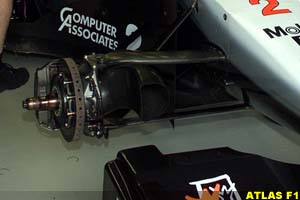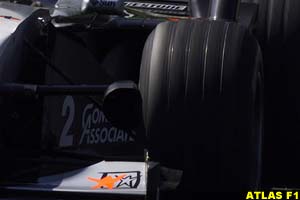| ATLAS F1 Volume 6, Issue 38 | |||
 |
The F1 Rulebook | ||
| by Will Gray, England | |||
|
In a series of articles, Will Gray delves into Formula One's rulebook and investigates the in-depth documentation that governs Formula One: from rules defining how the event should be run, to those restricting designers and engineers in technical areas
Part 10: The Bits that Fall Off!
Hanging off the chassis (hopefully not literally) are a number of very important components, which are paramount to a Formula One car's performance. The design of suspension, steering, and brakes can often make or break a Formula One car, so the FIA must strictly police the area, to ensure no team takes an unfair leap in their development. As these parts all hang off what is a very strong chassis, and often flail around in a collision, the rules are also there to ensure they are as safe as possible.
With the banning of driver aids, out went active suspension. A rule now states that the suspension's response reaction must result 'only from changes in vertical load applied to the wheels'. Because active suspension works by reading the track in front and positioning the wheels where they should be to avoid the bumps (acting, not reacting), this rule cuts out the possibilities of using the system. Many rules like this one are brought into being when teams develop a design idea that the FIA does not like.
A similar situation occurred when teams began designing suspension arms with a wing-section profile. To limit the possibility of obtaining downforce from this area, the rules now state that the cross section of any suspension component may not be more than 3.5 times as long as it is high, and that it must be at an angle of less than five degrees to the airflow. Further suspension rules demand that it is of fixed geometry, and that it is sprung by more than just the flex in the suspension arms - teams must use springs or torsion bars.
Braking is one of the biggest strengths of a Formula One car, and this comes mainly from the braking power available from its carbon brake disks, which must be no thicker than 28mm - this can cause problems with brake wear. During a race, the disks will be worn down by the force of the calipers which clasp onto them, and as they get thinner, they get hotter and become less efficient. As there is no minimum disk thickness, some teams have used special brake disks for qualifying, when wear is not a problem. These disks, which are much thinner and therefore much lighter, can save precious tenths to jump a couple of spots on the grid.
Although disks can be made of carbon, the calipers must be made of an aluminium alloy (with elastic modulus less than 80GPa). Only one caliper and one brake disk are allowed per wheel, and no more than two brake pads are permitted. In terms of brake operation, there must be one system with two separate hydraulic circuits which activate the calipers - one circuit for the front wheels and one for the rears.
These must be operated as one, with one single brake pedal. A couple of years ago, McLaren devised a brake-steer mechanism which used two pedals to create different pressures in the left and right brakes, and this assisted steering. Other teams began developing their own systems, but it was soon banned, and a rule now states that the system must be designed so that the pressures in each circuit (and therefore the power of braking on the left and right wheels) must be the same at all times.
As the heat created in the modern Formula One brake disk and caliper is so high, there is a constant demand to find more and more cooling. No liquid is allowed to be used in the brake cooling system, so it is down to the aerodynamicist to get as much air onto the brakes as possible. Brake ducts are used to scoop the air from the oncoming flow and feed it onto the brakes, and these can be dramatically seen on this year's McLaren. The teams will develop many different shapes in an aim to get greater airflow over the disks, and they will be tested in the wind tunnel throughout the year. To keep the designers on their toes, the brake ducts have a strict rulebox into which they must fit - no part of them can be above or below 14cm from the wheel centre line, they must extend no more than 12cm away from the inside rim of the wheel, and finally they must reach no further forward than the outside of the tyre, and no further rearward than the rim.
So components are kept well in check by the FIA, and if anyone gets an advance that the rules don't cover and the FIA think is unfair, they will stamp down on it pretty quickly!
Previous Parts in this Series:
Part 1 |
Part 2 |
Part 3 |
Part 4 |
Part 5 |
Part 6 |
Part 7 |
Part 8 |
Part 9
|
| Will Gray | © 2000 Kaizar.Com, Incorporated. |
| Send comments to: gray@atlasf1.com | Terms & Conditions |


